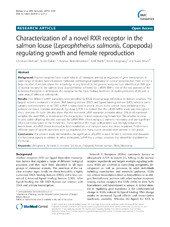| dc.contributor.author | Eichner, Christiane | eng |
| dc.contributor.author | Dalvin, Sussie Trine | eng |
| dc.contributor.author | Skern-Mauritzen, Rasmus | eng |
| dc.contributor.author | Malde, Ketil | eng |
| dc.contributor.author | Kongshaug, Heidi | eng |
| dc.contributor.author | Nilsen, Frank | eng |
| dc.date.accessioned | 2015-06-26T11:38:19Z | |
| dc.date.available | 2015-06-26T11:38:19Z | |
| dc.date.issued | 2015-02-14 | |
| dc.identifier.issn | 1471-2164 | en_US |
| dc.identifier.uri | http://hdl.handle.net/1956/10085 | |
| dc.description.abstract | Background: Nuclear receptors have crucial roles in all metazoan animals as regulators of gene transcription. A wide range of studies have elucidated molecular and biological significance of nuclear receptors but there are still a large number of animals where the knowledge is very limited. In the present study we have identified an RXR type of nuclear receptor in the salmon louse (Lepeophtheirus salmonis) (i.e. LsRXR). RXR is one of the two partners of the Ecdysteroid receptor in arthropods, the receptor for the main molting hormone 20-hydroxyecdysone (E20) with a wide array of effects in arthropods. Results: Five different LsRXR transcripts were identified by RACE showing large differences in domain structure. The largest isoforms contained complete DNA binding domain (DBD) and ligand binding domain (LBD), whereas some variants had incomplete or no DBD. LsRXR is transcribed in several tissues in the salmon louse including ovary, subcuticular tissue, intestine and glands. By using Q-PCR it is evident that the LsRXR mRNA levels vary throughout the L. salmonis life cycle. We also show that the truncated LsRXR transcript comprise about 50% in all examined samples. We used RNAi to knock-down the transcription in adult reproducing female lice. This resulted in close to zero viable offspring. We also assessed the LsRXR RNAi effects using a L. salmonis microarray and saw significant effects on transcription in the female lice. Transcription of the major yolk proteins was strongly reduced by knock-down of LsRXR. Genes involved in lipid metabolism and transport were also down regulated. Furthermore, different types of growth processes were up regulated and many cuticle proteins were present in this group. Conclusions: The present study demonstrates the significance of LsRXR in adult female L. salmonis and discusses the functional aspects in relation to other arthropods. LsRXR has a unique structure that should be elucidated in the future. | en_US |
| dc.language.iso | eng | eng |
| dc.publisher | BioMed Central | en_US |
| dc.rights | Copyright 2015 Eichner et al.; licensee BioMed Central. | eng |
| dc.rights.uri | http://creativecommons.org/licenses/by/4.0 | eng |
| dc.subject | Ultraspiracle | eng |
| dc.subject | Retinoid X receptor | eng |
| dc.subject | Sea louse | eng |
| dc.subject | Copepod | eng |
| dc.subject | Atlantic salmon | eng |
| dc.subject | RNAi | eng |
| dc.subject | Microarray | eng |
| dc.title | Characterization of a novel RXR receptor in the salmon louse (Lepeophtheirus salmonis, Copepoda) regulating growth and female reproduction | en_US |
| dc.type | Peer reviewed | |
| dc.type | Journal article | |
| dc.date.updated | 2015-06-26T11:32:22Z | |
| dc.description.version | publishedVersion | en_US |
| dc.source.articlenumber | 81 | |
| dc.identifier.doi | https://doi.org/10.1186/s12864-015-1277-y | |
| dc.identifier.cristin | 1227673 | |
| dc.source.journal | BMC Genomics | |
| dc.source.40 | 16 | |

